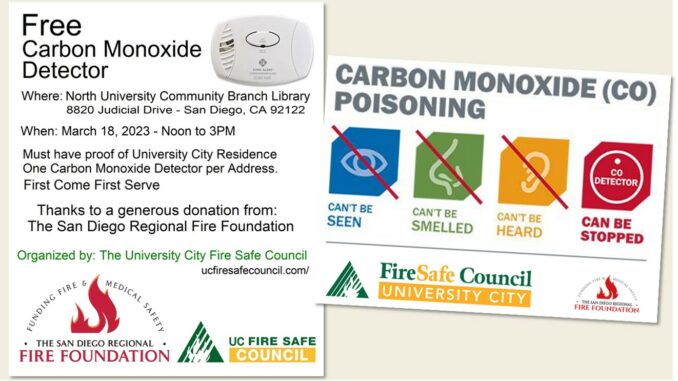
The University City Fire Safe Council is hosting a Carbon Monoxide detector giveaway event in the parking lot at the North University City Library, 8820 Judicial Drive, on Saturday, March 18, from noon to 3 PM (or while supplies last). Recipient must live in University City and have proof of residence. There is a limit of one CO detector per household. This safety initiative is made possible by a generous grant from the San Diego Regional Fire Foundation. For more information, contact: UCFireSafeCouncil@gmail.com
How to Prevent Carbon Monoxide (CO) Poisoning; Tips from the Mayo Clinic
Carbon monoxide is a colorless, odorless, tasteless gas produced by burning gasoline, wood, propane, charcoal or other fuel. Improperly ventilated appliances and engines, particularly in a tightly sealed or enclosed space, may allow carbon monoxide to accumulate to dangerous levels.
Carbon monoxide poisoning occurs when carbon monoxide builds up in your bloodstream. When too much carbon monoxide is in the air, your body replaces the oxygen in your red blood cells with carbon monoxide. This can lead to serious tissue damage, or even death.
The simplest way to help prevent carbon monoxide poisoning is to install carbon monoxide detectors. Put one in the hallway near each sleeping area in your house. Check the batteries every time you check your smoke detector batteries — at least twice a year. If the alarm sounds, leave the house and call 9-1-1 the fire department.
Other preventative measures from the Mayo Clinic staff include:
- Open the garage door before starting your car.
- Use gas appliances as recommended.
- Keep your fuel-burning appliances and engines properly vented.
- Ask your utility company about yearly checkups for all gas appliances, including your furnace.
- If you have a fireplace, keep it in good repair. Clean your fireplace chimney and flue every year.
- Make repairs before returning to the site of an incident.
Use caution when working with solvents in a closed area. Methylene chloride, a solvent commonly found in paint and varnish removers, can break down (metabolize) into carbon monoxide when inhaled. Exposure to methylene chloride can cause carbon monoxide poisoning.
For more information about the University City Fire Safe Council, visit: https://www.ucfiresafecouncil.com/
See also: https://www.universitycitynews.org/fire-safe-council-university-city/


